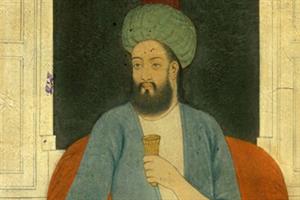PDF chapter test TRY NOW
Literatures:
Tabakat-i-Nasiri was written by Minhaj-us-Siraj, who was patronised by Sultan Nazir-ud-din Mahmud of the Slave Dynasty. The compendium covers the period from Muhammad Ghori's conquest to \(A.D. (C.E.) \)\(1260\). His patron inspired the title of the compilation. Hasan Nizami, a Ghazni migrant, wrote in the \(13^t\)\(^h\) century. Towards the end of Iltutmish's reign, Taj-ul-Ma'asir was established.

It is the first official history of the Delhi Sultanate and contains details about Qutb-ud-din Aibak. Tarikh-i-Firoz Shahi was written by Zia-ud-Barni, a courtier of Muhammad Tughluq, and covered the Delhi Sultanate's history from Ghiyas-ud-din Balban to the early years of Firoz Shah Tughluq's reign.

Qutb-ud-din Aibak
The Tarikh-i-Frishta (\(16^t\)\(^h\) century) by Ferishta is about the rise of Mughal forces in India.
Emperor Babur's Babur Nama and Abul Fazal'sAin-i-Akbari and Akbar Nama, both written in the \(16^t\)\(^h\) century, offered extensive details about these two emperors.
Jahangir's memoir, Tuzk-i-Jahangiri, was written in the \(17^t\)\(^h\) century and shed a lot of light on the period. Apart from emperor autobiographies, Nizam-ud-din Ahmad's, Tabakat-i-Akbari is considered more credible than Abul Fazal's exaggerated account. Similarly, Tarikh-i-Badauni (Badauni's History), Badauni's outstanding work, was published in \(1595\).
This work is divided into three sections. The volume on Akbar's reign is a candid and critical look at the emperor's administration, especially his religious policies.
Reference:
https://www.tutorialathome.in/postimg/2018/06/muhammad-ghori-01.jpg
https://www.tutorialathome.in/postimg/2018/06/muhammad-ghori-01.jpg
